Expenditures of the Aged Chartbook, 2010
About This Chartbook
Source of the Data
Expenditures of the Aged Chartbook is based on data from the 2010 Consumer Expenditure Survey Public-Use File. The survey provides continuous comprehensive data on the buying habits of US consumers. The survey is representative of the total civilian noninstitutionalized population of the United States, as well as that portion of the institutionalized population living in group quarters (excluding military personnel living on military bases and residents of nursing homes).
The Consumer Expenditure Survey program consists of two separate components, each with its own questionnaire and independent sample:
- An interview survey, which collects data on monthly expenditures such as housing.
- A diary survey, which collects weekly expenditures of frequently purchased items such as food and beverages.
The Census Bureau collects the data under contract with the Bureau of Labor Statistics. Further details on the Consumer Expenditure Survey program are available at http://www.bls.gov/cex/home.htm. Documentation on the two survey components and their integration, as well as limitations of the data, are found on the Frequently Asked Questions page at http://www.bls.gov/cex/csxfaqs.htm. In this chartbook, medians and distributions are calculated using only the interview survey. Means are calculated using data from both the interview and diary surveys. The mean household expenditure for each expenditure category is the sum of spending for that category by all households divided by the sum of total expenditures for all households.
Surveys are subject to sampling error because observations are not taken for the entire population. Information on the sampling error in the 2010 Survey of Consumer Expenditures can be found in the survey documentation available at http://www.bls.gov/cex/2010/csxintvw.pdf.
Definition and Explanation of Key Terms
The definitions of key terms are abbreviated versions of those used by the Bureau of Labor Statistics, which presents detailed definitions in its glossary at http://www.bls.gov/cex/csxgloss.htm.
Unit of analysis
Consumer unit (CU). Expenditures in the Consumer Expenditure Survey are measured for the CU, defined as the members of a household related by blood, marriage, adoption, or some other legal arrangement; a single person living alone or sharing a household with others but who is financially independent; or two or more persons living together who share responsibility for at least two of the following three major expense categories: food, housing, and other (comprising various items, listed below under "Components of expenditures"). Students living in university-sponsored housing also are included in the sample as separate CUs. The Consumer Expenditure Survey is a survey of the noninstitutionalized population and therefore does not include nursing home residents and their expenditures.
Reference person. The first CU member mentioned by the respondent when asked to "Start with the name of the person or one of the persons who owns or rents the home." The relationship of the other members of the CU is determined with respect to this person.
Age of the CU. The age of the reference person.
Size of the CU. The number of persons whose usual place of residence at the time of the interview is in the sample unit. In the interview portion of the 2010 Consumer Expenditure Survey, the size of the CU decreased as the age of the CU increased, as shown in the chart below. The average number of persons in a CU, by age of the unit, was 2.2 for CUs aged 55–64, 1.9 for those aged 65–74, and 1.6 for those 75 or older.
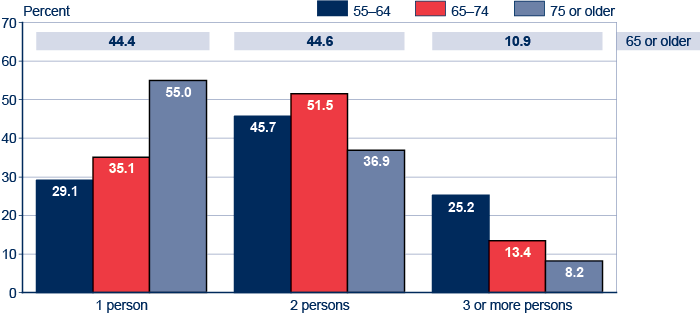
| Size of consumer unit | 55–64 | 65–74 | 75 or older | 65 or older |
|---|---|---|---|---|
| 1 person | 29.1 | 35.1 | 55.0 | 44.4 |
| 2 persons | 45.7 | 51.5 | 36.9 | 44.6 |
| 3 or more persons | 25.2 | 13.4 | 8.2 | 10.9 |
Expenditures and income
Total expenditures. The sum of all expenditures in 2010.
Per capita expenditures. Expenditures of CUs divided by the size of the CU.
Total income. The sum of all income sources before taxes in 2010, including the value of food stamps.
Earned income. Income from wages and salaries or self-employment in 2010, including income from businesses and farms.
Components of expenditures
Housing. The sum of all housing expenditures in 2010, including the expenses associated with renting or owning a home such as rent, mortgage interest, property taxes, maintenance, utilities, furnishings, renters' or homeowners' insurance, home appliances, cleaning supplies, textiles, and luggage. It does not include payments toward mortgage principal, which are considered by most economists to be part of household savings rather than expenditures. Housing tenure refers to the CU's principal place of residence during the survey. "Owners" include CUs living in their own homes, cooperatives or condominium apartments, or townhouses. "Renters" include CUs paying rent or living rent-free in lieu of wages.
Food. The sum of all food expenditures in 2010, including expenditures made at grocery stores and restaurants.
Health care. The sum of all out-of-pocket health care expenditures in 2010, including public and private health insurance, doctor visits, eye and dental care and aids, hospital services, lab tests, and prescription drugs.
Transportation. The sum of all transportation expenditures in 2010, including the purchase of new and used cars and trucks; insurance; gas and motor oil; finance charges; maintenance and repairs; licenses; rentals; other charges; and fares for travel by airplane, bus, train, and taxi.
Apparel. The sum of all apparel expenditures in 2010, including clothing, footwear, laundry, sewing, watches, jewelry, and storage.
Entertainment. The sum of all entertainment expenditures in 2010, including club fees, sport fees, theater tickets, televisions, stereos, pet expenses, toys, hobbies, campers, boats, and sporting equipment.
Other. The sum of all other expenditures in 2010, including those for alcohol, personal care, reading, education, tobacco, miscellaneous items, cash contributions to persons or organizations outside the CU, personal insurance, pension contributions, and Social Security payroll taxes.
Travel. Travel is a combination of the above categories presented as the sum of all expenditures on out-of-town trips in 2010, including those for food; alcohol; lodging; gas; rental of autos, trucks, motorcycles, boats, campers, and other vehicles; parking; tolls; fares for travel by airplane, bus, train, and taxi; and recreation and entertainment.
Notes about the Data
Data in this report reflect expenditures in 2010. The Trends section also includes comparative data on expenditures in 2002 and 2005.
Data are from the interview portion of the 2010 Consumer Expenditure Survey, unless otherwise noted.
Some charts contain data from an integration of the diary and the interview portions of the 2010 Consumer Expenditure Survey. Some expenditure items are measured in either the interview survey or the diary survey; others are measured in both the interview survey and the diary survey. In the latter cases, the data source used for a given item is the survey that yields the smallest standard error for that item. Items are aggregated into summary categories that may include data from both the interview and diary portions.
Charts variously show mean, median, and percentile values. Because means can be influenced by high-spending outliers, mean expenditure data can be highly skewed. In those cases, median and percentile figures provide a clearer picture of the distribution of expenditures. However, the interview and diary portions cannot be combined to calculate medians and percentiles because the two surveys have different questionnaires and samples.
Expenditure data are collected at the CU level.
Estimates are based on weighted responses from a sample of the population, as follows:
| Age group | Unweighted | Weighted (millions) |
|---|---|---|
| 55–64 | 1,548 | 21.4 |
| 65–74 | 997 | 13.0 |
| 75 or older | 850 | 11.6 |
| 65 or older | 1,847 | 24.6 |
The estimates in this chartbook, which are based on the 2010 Consumer Expenditure Survey Public-Use File, may vary from those published by the Bureau of Labor Statistics because some Public-Use data are adjusted to prevent the disclosure of respondents' personal information.
Income figures refer to income before taxes. Those figures include some noncash benefits, such as the value of food stamps.
Expenditures include Social Security payroll taxes and property taxes on owned dwellings and vacation homes.
Income quartiles for CUs aged 65 or older are four groups of roughly equal size as determined by their income level, as follows:
| Quartile | Income |
|---|---|
| Lowest | $16,207 or less |
| Low-middle | More than $16,207 but less than or equal to $28,668 |
| High-middle | More than $28,668 but less than or equal to $51,148 |
| Highest | More than $51,148 |
The 2004 Consumer Expenditure Survey was the first in which the Bureau of Labor Statistics imputed income for units that did not report their amounts and sources of income. In the previous edition of this chartbook, which was based on the 2002 Consumer Expenditure Survey, CUs that did not have complete income information were excluded from the analysis. This edition includes CUs that reported their income as well as those for which the Bureau of Labor Statistics imputed income.
Charts that show data by age group also show aggregate data for CUs aged 65 or older in a shaded bar in (or adjacent to) the chart.
In charts showing percentage distributions, totals do not necessarily equal the sum of rounded components.
Some charts present data as box plots. The upper and lower edges of the box plots represent the values at the 75th and 25th percentiles. The box therefore presents the interquartile range, or the middle 50 percent of the data, to indicate the variability of the values. Within the box, a third horizontal line indicates the median (50th percentile) value. A diamond symbol (♦) indicates the mean. A sample box plot appears below.
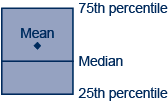
CUs Aged 65 or Older
Total Expenditures
Annual expenditure amounts for all CUs aged 65 or older ranged widely. In 2010, almost 20 percent spent less than $15,000, and 19 percent spent $50,000 or more. Median expenditures were $26,486. A relatively small proportion of CUs with very high expenditures strongly influenced the overall mean, which was $35,274. (Median and mean values are not shown.)
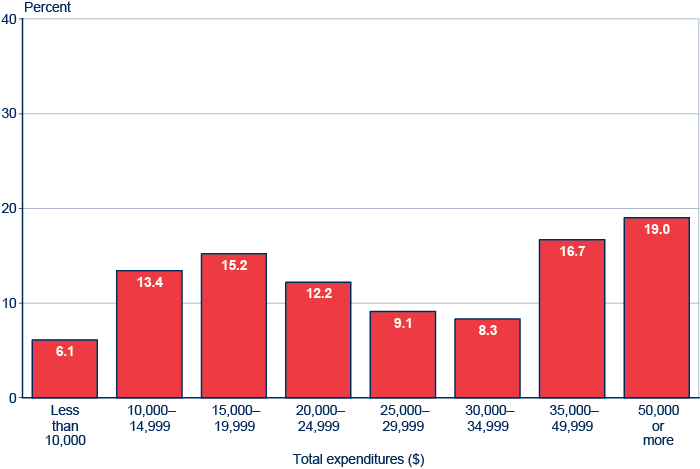
| Total expenditures ($) | Percent |
|---|---|
| Less than 10,000 | 6.1 |
| 10,000–14,999 | 13.4 |
| 15,000–19,999 | 15.2 |
| 20,000–24,999 | 12.2 |
| 25,000–29,999 | 9.1 |
| 30,000–34,999 | 8.3 |
| 35,000–49,999 | 16.7 |
| 50,000 or more | 19.0 |
Per Capita Expenditures
Per capita expenditures account for differences in the number of persons in a CU. Forty-one percent of CUs aged 65 or older had per capita expenditures of less than $15,000, and 32 percent had per capita expenditures of $15,000–$24,999. Median ($16,957) and mean ($21,947) per capita expenditures equaled almost two-thirds of median and mean total expenditures for CUs aged 65 or older ($26,846 and $35,274, respectively; values not shown).
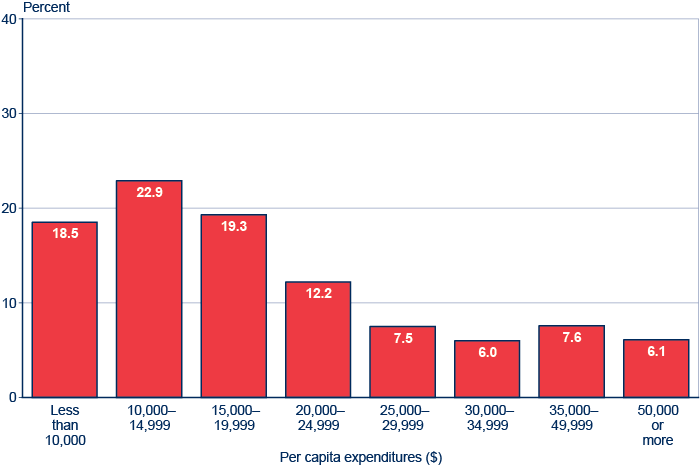
| Per capita expenditures ($) | Percent |
|---|---|
| Less than 10,000 | 18.5 |
| 10,000–14,999 | 22.9 |
| 15,000–19,999 | 19.3 |
| 20,000–24,999 | 12.2 |
| 25,000–29,999 | 7.5 |
| 30,000–34,999 | 6.0 |
| 35,000–49,999 | 7.6 |
| 50,000 or more | 6.1 |
Expenditures, by Income Quartile
For CUs aged 65 or older, median expenditures in the highest income quartile ($55,446) more than tripled those in the lowest income quartile ($16,443). In the lowest income quartile, expenditures at the 25th and 75th percentiles were $11,918 and $23,257, respectively; the corresponding values in the highest income quartile were $40,859 and $78,857. Although the difference in spending between the 25th and 75th expenditure percentiles was greater in absolute terms in the highest income quartile than in the lowest income quartile, in relative terms the patterns were quite similar. In all four income quartiles, expenditures at the 75th percentile were about 1.9 times greater than expenditures at the 25th percentile.
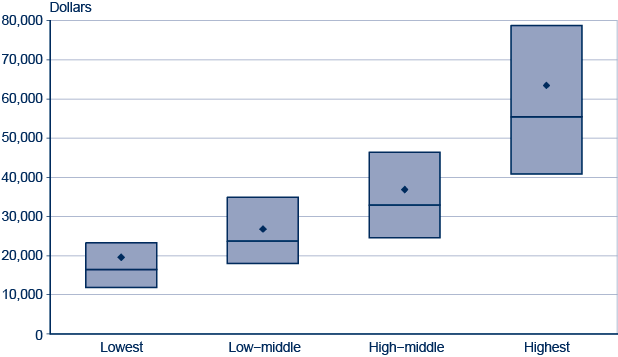
| Lowest | Low-middle | High-middle | Highest | |
|---|---|---|---|---|
| 75th percentile | 23,257 | 34,974 | 46,467 | 78,857 |
| Median | 16,443 | 23,771 | 32,941 | 55,446 |
| 25th percentile | 11,918 | 18,077 | 24,540 | 40,859 |
| Mean (♦) | 19,593 | 26,804 | 36,909 | 63,487 |
| SOURCE: Interview portion of the 2010 Consumer Expenditure Survey. Means were computed using both the interview and diary portions of the survey. | ||||
Per Capita Expenditures, by Income Quartile
Median per capita expenditures for CUs aged 65 or older in the highest income quartile ($27,913) were 90 percent higher than those in the lowest income quartile ($14,615). Per capita expenditures at the 25th and 75th percentiles of the lowest income quartile were $10,139 and $20,627, respectively. In the highest income quartile, 25th and 75th percentile per capita expenditures were $18,474 and $42,288, respectively.
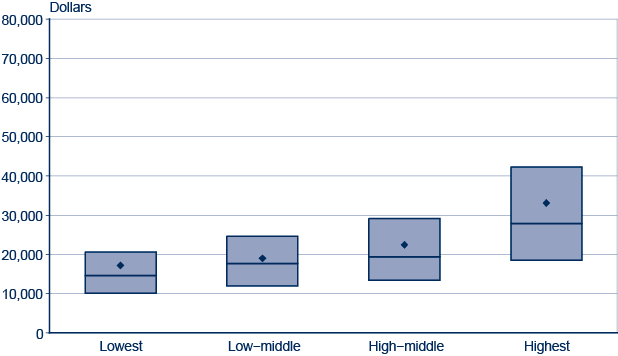
| Lowest | Low-middle | High-middle | Highest | |
|---|---|---|---|---|
| 75th percentile | 20,627 | 24,634 | 29,141 | 42,288 |
| Median | 14,615 | 17,665 | 19,396 | 27,913 |
| 25th percentile | 10,139 | 12,003 | 13,413 | 18,474 |
| Mean (♦) | 17,224 | 19,006 | 22,450 | 33,101 |
| SOURCE: Interview portion of the 2010 Consumer Expenditure Survey. | ||||
Expenditures, by Earned Income Status
Although not shown in the chart below, median expenditures for CUs aged 65 or older with no earned income ($22,848) equaled 56 percent of median expenditures for those with earned income ($40,742). Almost three-quarters (74 percent) of CUs aged 65 or older had no earned income. The chart shows that 42 percent of CUs with no earned income spent less than $20,000 annually, compared with 14 percent of those with earned income. Conversely, 35 percent of CUs with earned income spent $50,000 or more, compared with only 14 percent with no earned income. Per capita expenditures exhibited similar patterns.
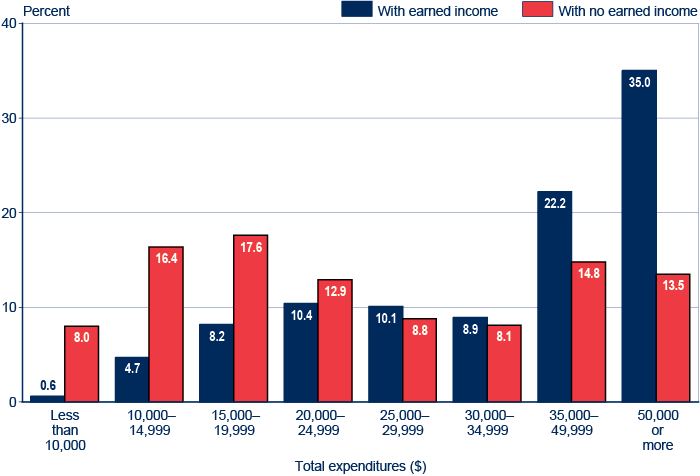
| Total expenditues ($) | With earned income | With no earned income |
|---|---|---|
| Less than 10,000 | 0.6 | 8.0 |
| 10,000–14,999 | 4.7 | 16.4 |
| 15,000–19,999 | 8.2 | 17.6 |
| 20,000–24,999 | 10.4 | 12.9 |
| 25,000–29,999 | 10.1 | 8.8 |
| 30,000–34,999 | 8.9 | 8.1 |
| 35,000–49,999 | 22.2 | 14.8 |
| 50,000 or more | 35.0 | 13.5 |
Components of Expenditures
Housing was the largest component of expenditures (35 percent) for CUs aged 65 or older. Other large components included transportation (14 percent), out-of-pocket health care (13 percent), and food (12 percent). Smaller components included entertainment (5 percent) and apparel (3 percent). Other types of expenditures, including those for alcohol, personal care, reading, education, tobacco, miscellaneous items, cash contributions to persons or organizations outside the CU, personal insurance, pension contributions, and Social Security payroll taxes, accounted for 17 percent. Social Security payroll taxes and pension contributions were small components of total expenditures (3 percent and 1 percent, respectively). Per capita expenditures were similarly distributed.
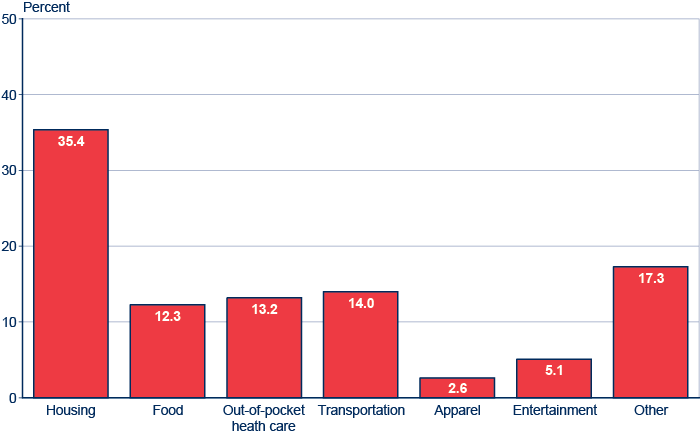
Components of Expenditures, by Earned Income Status
CUs aged 65 or older spent similar shares on the various expenditure components regardless of whether they had earned income. Housing was the largest expenditure for both groups (34 percent for those with earned income and 36 percent for those with no earned income). Expenditures for out-of-pocket health care, food, and transportation ranged from 11 percent to 15 percent. Entertainment and apparel were smaller components, ranging from 2 percent to 5 percent. Other expenditures accounted for 22 percent of total expenditures for those with earned income (including 7 percent for Social Security payroll taxes and 2 percent for pension contributions) and 15 percent of total expenditures for those with no earned income (CUs with no earned income would not incur Social Security payroll taxes or pension contributions).
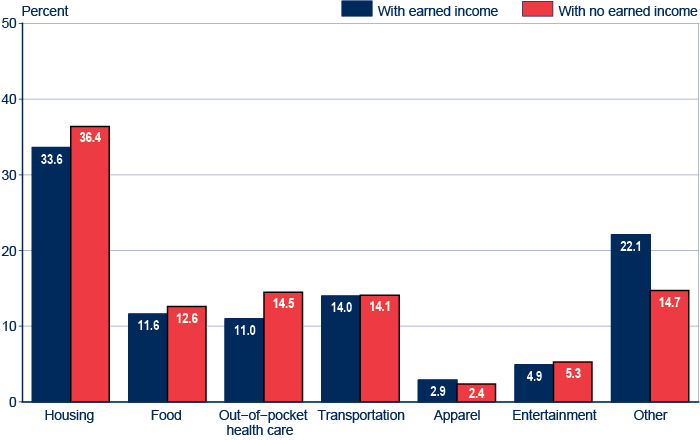
| Component | With earned income | With no earned income |
|---|---|---|
| Housing | 33.6 | 36.4 |
| Food | 11.6 | 12.6 |
| Out-of-pocket health care | 11.0 | 14.5 |
| Transportation | 14.0 | 14.1 |
| Apparel | 2.9 | 2.4 |
| Entertainment | 4.9 | 5.3 |
| Other | 22.1 | 14.7 |
Components of Expenditures, by Selected Income Quartile
The proportion of expenditures allocated for housing, food, and out-of-pocket health care was 27 percent higher for CUs in the lowest income quartile than for those in the highest income quartile. CUs aged 65 or older in the lowest income quartile spent 43 percent of their total expenditures on housing compared with 33 percent for those in the highest income quartile. Food made up 14 percent of expenditures for CUs in the lowest income quartile and 12 percent for those in the highest income quartile. Out-of-pocket spending for health care accounted for 14 percent of expenditures in the lowest income quartile, compared with 11 percent in the highest quartile. Both income groups allocated similar percentages to entertainment and apparel. CUs in the highest income quartile allocated twice the proportion of expenditures to the "other" category as did CUs in the lowest income quartile (22 percent compared with 11 percent).
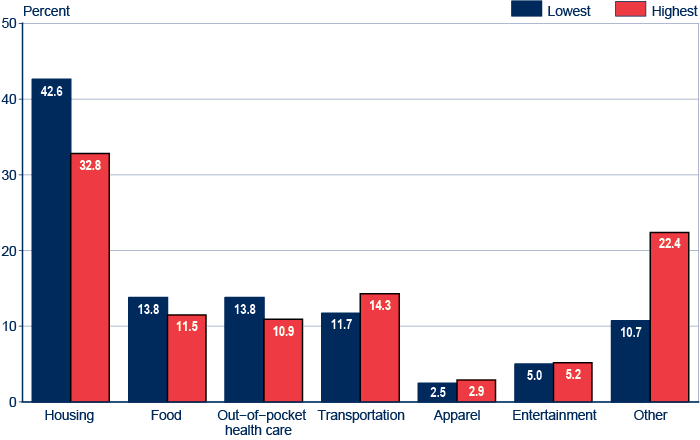
| Component | Lowest | Highest |
|---|---|---|
| Housing | 42.6 | 32.8 |
| Food | 13.8 | 11.5 |
| Out-of-pocket health care | 13.8 | 10.9 |
| Transportation | 11.7 | 14.3 |
| Apparel | 2.5 | 2.9 |
| Entertainment | 5.0 | 5.2 |
| Other | 10.7 | 22.4 |
CUs, by Age
Total Expenditures
Expenditure amounts varied by age. This section of the chartbook examines three age groups: 55–64, 65–74, and 75 or older. Median expenditures for CUs aged 55–64 ($37,580) were 73 percent higher than those of CUs aged 75 or older ($21,654). For CUs aged 55–64, 25th and 75th percentile expenditures were $23,336 and $59,337, respectively; the corresponding values for CUs aged 75 or older were $14,577 and $35,787. Per capita expenditures followed the same pattern.
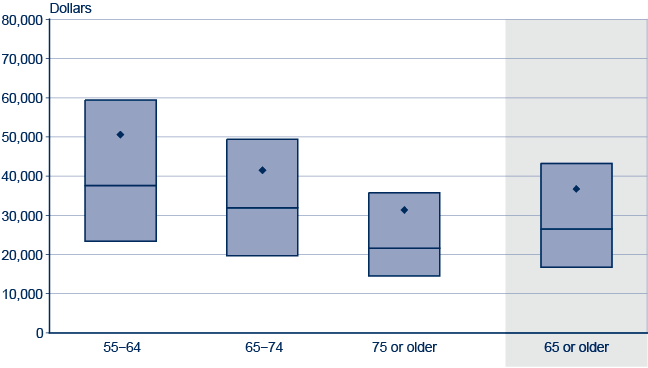
| 55–64 | 65–74 | 75 or older | 65 or older | |
|---|---|---|---|---|
| 75th percentile | 59,377 | 49,382 | 35,787 | 43,264 |
| Median | 37,580 | 31,938 | 21,654 | 26,486 |
| 25th percentile | 23,336 | 19,721 | 14,577 | 16,790 |
| Mean (♦) | 50,588 | 41,473 | 31,361 | 36,739 |
| SOURCE: Interview portion of the 2010 Consumer Expenditure Survey. Means were computed using both the interview and diary portions of the survey. | ||||
Components of Expenditures
The distribution of spending among expenditure components varied slightly by age, with the largest share going to housing for all age groups. CUs aged 75 or older allocated 15 percent of expenditures to out-of-pocket health care, almost twice the 8 percent share for those aged 55–64. Compared with CUs aged 55–64, those aged 75 or older allocated less of their expenditures to transportation (13 percent versus 16 percent) and to other expenditures (17 percent versus 23 percent). The shares of expenditures allocated to food and housing were generally similar for all three age groups (ranging from 12 percent to 13 percent and from 33 percent to 36 percent, respectively), and only small proportions were allocated to entertainment (from 4 percent to 6 percent) and apparel (from 2 percent to 3 percent).
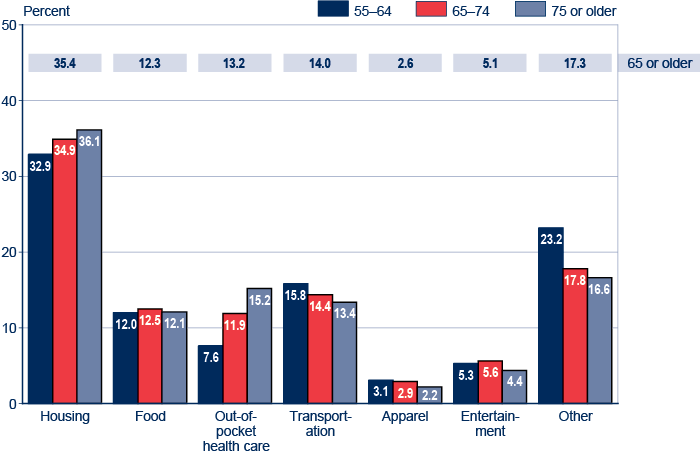
| Component | 55–64 | 65–74 | 75 or older | 65 or older |
|---|---|---|---|---|
| Housing | 32.9 | 34.9 | 36.1 | 35.4 |
| Food | 12.0 | 12.5 | 12.1 | 12.3 |
| Out-of-pocket health care | 7.6 | 11.9 | 15.2 | 13.2 |
| Transportation | 15.8 | 14.4 | 13.4 | 14.0 |
| Apparel | 3.1 | 2.9 | 2.2 | 2.6 |
| Entertainment | 5.3 | 5.6 | 4.4 | 5.1 |
| Other | 23.2 | 17.8 | 16.6 | 17.3 |
Housing Expenditures
Housing was the largest component of expenditures for all three age groups. The median share of expenditures allocated to housing was about 37 percent for all three age groups. The median amount spent on housing declined for successively older groups, from $13,296 for CUs aged 55–64 to $10,784 for CUs aged 65–74 and $7,832 for CUs aged 75 or older. At the 25th and 75th percentiles, respective housing expenditures were $8,144 and $21,844 for CUs aged 55–64 and $4,932 and $12,996 for CUs aged 75 or older. Per capita median housing expenditures were $6,965 for the 55–64 age group and $5,508 for those aged 75 or older.
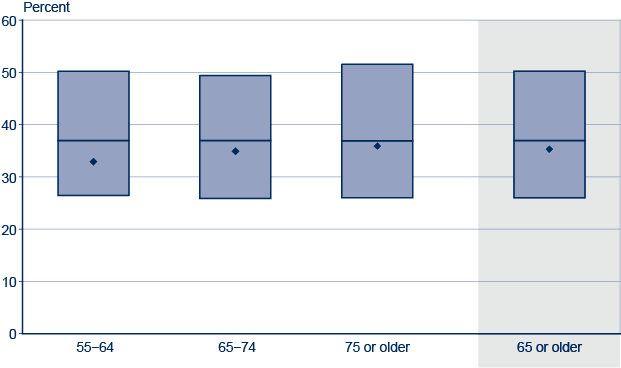
| 55–64 | 65–74 | 75 or older | 65 or older | |
|---|---|---|---|---|
| 75th percentile | 50.2 | 49.4 | 51.5 | 50.2 |
| Median | 37.0 | 37.0 | 36.9 | 37.0 |
| 25th percentile | 26.4 | 25.9 | 26.0 | 26.0 |
| Mean (♦) | 32.9 | 34.9 | 35.9 | 35.3 |
| SOURCE: Interview portion of the 2010 Consumer Expenditure Survey. Means were computed using both the interview and diary portions of the survey. | ||||
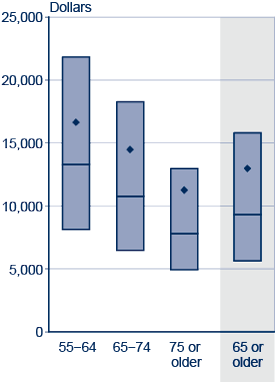
| 55–64 | 65–74 | 75 or older | 65 or older | |
|---|---|---|---|---|
| 75th percentile | 21,844 | 18,280 | 12,996 | 15,816 |
| Median | 13,296 | 10,784 | 7,832 | 9,319 |
| 25th percentile | 8,144 | 6,477 | 4,932 | 5,628 |
| Mean (♦) | 16,654 | 14,490 | 11,273 | 12,981 |
| SOURCE: Interview portion of the 2010 Consumer Expenditure Survey. Means were computed using both the interview and diary portions of the survey. | ||||
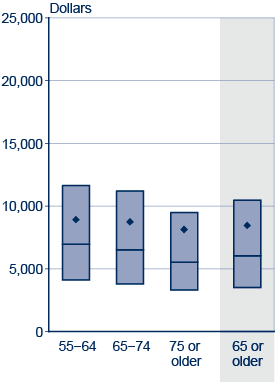
| 55–64 | 65–74 | 75 or older | 65 or older | |
|---|---|---|---|---|
| 75th percentile | 11,654 | 11,218 | 9,496 | 10,458 |
| Median | 6,965 | 6,530 | 5,508 | 6,032 |
| 25th percentile | 4,120 | 3,788 | 3,312 | 3,512 |
| Mean (♦) | 8,925 | 8,750 | 8,136 | 8,463 |
| SOURCE: Interview portion of the 2010 Consumer Expenditure Survey. Means were computed using both the interview and diary portions of the survey. | ||||
Housing Tenure
About 80 percent of CUs in all three age groups owned a home, and the proportion of CUs that owned a home without a mortgage increased with age. Homeowners aged 55–64 were the least likely to own without a mortgage (about 35 percent). Among homeowners aged 65–74, those with no mortgage nearly doubled those with a mortgage (54 percent compared with 29 percent), and homeowners aged 75 or older were approximately 5 times more likely not to have a mortgage than to have one (68 percent compared with 13 percent). The mean percentage of total expenditures allocated to housing was lowest for homeowners without a mortgage (between 28 percent and 32 percent) and highest for CUs who rent (40 percent to 49 percent).

| Housing tenure | 55–64 | 65–74 | 75 or older | 65 or older |
|---|---|---|---|---|
| Owner with mortgage | 44.8 | 29.2 | 13.2 | 21.7 |
| Owner without mortgage | 35.2 | 53.9 | 67.6 | 60.3 |
| Renter | 20.0 | 16.9 | 19.2 | 18.0 |

| Housing tenure | 55–64 | 65–74 | 75 or older | 65 or older |
|---|---|---|---|---|
| Owner with mortgage | 34.2 | 38.6 | 41.2 | 39.2 |
| Owner without mortgage | 27.6 | 30.1 | 31.6 | 30.8 |
| Renter | 40.0 | 43.6 | 48.5 | 45.9 |
Food Expenditures
The median percentage of total expenditures spent on food was about 16 percent for CUs aged 55–64 and 17 percent for those in the two older age groups. Including all age groups, the 25th and 75th percentile values ranged from 11 percent to 24 percent, respectively. The median amount spent on food was 63 percent higher for CUs aged 55–64 ($5,948) than for CUs aged 75 or older ($3,640). Median per capita food expenditures were about one-fifth higher for CUs aged 55–64 ($3,060) than for CUs aged 75 or older ($2,600).
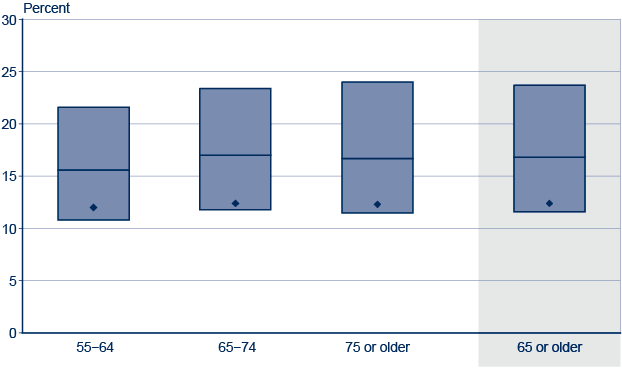
| 55–64 | 65–74 | 75 or older | 65 or older | |
|---|---|---|---|---|
| 75th percentile | 21.6 | 23.4 | 24.0 | 23.7 |
| Median | 15.6 | 17.0 | 16.7 | 16.8 |
| 25th percentile | 10.8 | 11.8 | 11.5 | 11.6 |
| Mean (♦) | 12.0 | 12.4 | 12.3 | 12.4 |
| SOURCE: Interview portion of the 2010 Consumer Expenditure Survey. Means were computed using both the interview and diary portions of the survey. | ||||
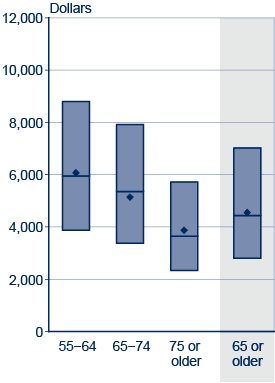
| 55–64 | 65–74 | 75 or older | 65 or older | |
|---|---|---|---|---|
| 75th percentile | 8,808 | 7,920 | 5,720 | 7,020 |
| Median | 5,948 | 5,356 | 3,640 | 4,440 |
| 25th percentile | 3,872 | 3,380 | 2,340 | 2,808 |
| Mean (♦) | 6,072 | 5,143 | 3,873 | 4,555 |
| SOURCE: Interview portion of the 2010 Consumer Expenditure Survey. Means were computed using both the interview and diary portions of the survey. | ||||
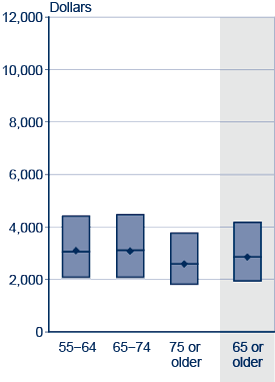
| 55–64 | 65–74 | 75 or older | 65 or older | |
|---|---|---|---|---|
| 75th percentile | 4,410 | 4,472 | 3,762 | 4,176 |
| Median | 3,060 | 3,120 | 2,600 | 2,860 |
| 25th percentile | 2,080 | 2,080 | 1,820 | 1,950 |
| Mean (♦) | 3,096 | 3,082 | 2,591 | 2,854 |
| SOURCE: Interview portion of the 2010 Consumer Expenditure Survey. Means were computed using both the interview and diary portions of the survey. | ||||
Food Prepared and Eaten at Home
Older age groups allocated a larger share of food expenditures to food prepared and eaten at home than did younger age groups. CUs aged 75 or older were more likely to allocate 95 percent or more of their food expenditures to food prepared and eaten at home than were CUs aged 55–64 (36 percent compared with 22 percent). The average percentage of food expenditures allocated to food prepared and eaten at home was 61 percent for CUs aged 55–64, 63 percent for CUs aged 65–74, and 68 percent for CUs aged 75 or older (not shown).
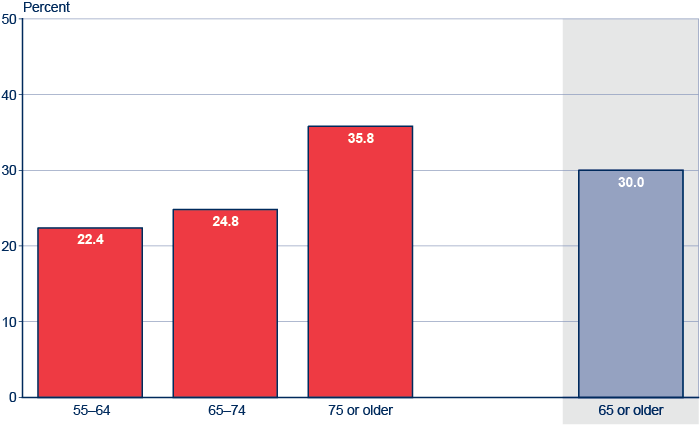
Out-of-Pocket Health Care Expenditures
Median out-of-pocket health care expenditures ranged from 5 percent of total expenditures for CUs aged 55–64 to 14 percent for those aged 75 or older. From the 25th to the 75th percentiles, the share of total expenditures allocated to health care ranged from 1 percent to 11 percent for CUs aged 55–64 and from 8 percent to 23 percent for CUs aged 75 or older. Median out-of-pocket health care expenditures for CUs aged 75 or older ($3,122) were more than 40 percent higher than those of CUs aged 55–64 ($2,176) but were almost double on a per capita basis ($2,263 compared with $1,140). The Consumer Expenditure Survey covers the noninstitutionalized population and therefore omits nursing home residents and their expenditures.
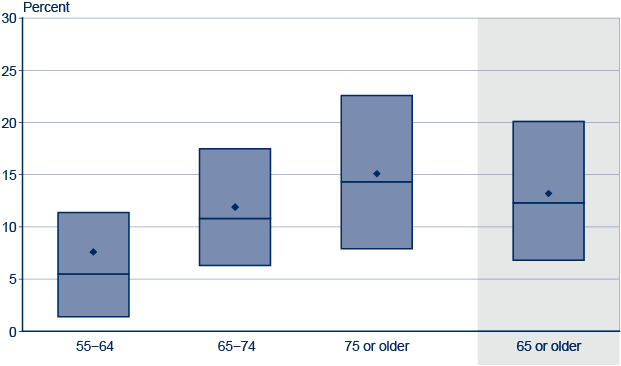
| 55–64 | 65–74 | 75 or older | 65 or older | |
|---|---|---|---|---|
| 75th percentile | 11.4 | 17.5 | 22.6 | 20.1 |
| Median | 5.5 | 10.8 | 14.3 | 12.3 |
| 25th percentile | 1.4 | 6.3 | 7.9 | 6.8 |
| Mean (♦) | 7.6 | 11.9 | 15.1 | 13.2 |
| SOURCE: Interview portion of the 2010 Consumer Expenditure Survey. Means were computed using both the interview and diary portions of the survey. | ||||
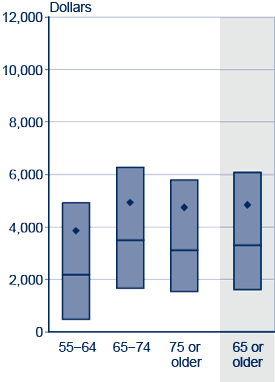
| 55–64 | 65–74 | 75 or older | 65 or older | |
|---|---|---|---|---|
| 75th percentile | 4,928 | 6,278 | 5,801 | 6,085 |
| Median | 2,176 | 3,509 | 3,122 | 3,317 |
| 25th percentile | 480 | 1,668 | 1,548 | 1,620 |
| Mean (♦) | 3,858 | 4,935 | 4,746 | 4,846 |
| SOURCE: Interview portion of the 2010 Consumer Expenditure Survey. Means were computed using both the interview and diary portions of the survey. | ||||
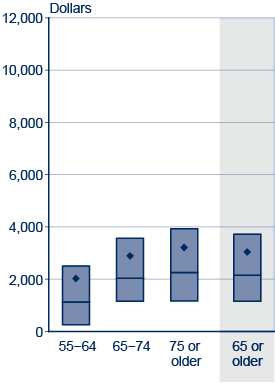
| 55–64 | 65–74 | 75 or older | 65 or older | |
|---|---|---|---|---|
| 75th percentile | 2,512 | 3,569 | 3,927 | 3,721 |
| Median | 1,140 | 2,041 | 2,263 | 2,149 |
| 25th percentile | 260 | 1,157 | 1,178 | 1,157 |
| Mean (♦) | 2,030 | 2,895 | 3,219 | 3,047 |
| SOURCE: Interview portion of the 2010 Consumer Expenditure Survey. Means were computed using both the interview and diary portions of the survey. | ||||
Components of Out-of-Pocket Health Care Expenditures
Health insurance premiums accounted for the largest share of out-of-pocket health care spending for all age groups (from 55 percent to 64 percent). Medical services were the second largest component of health care expenditures for CUs aged 55–64, and drugs were the second largest component for CUs aged 75 or older. Medical supplies accounted for only about 3 percent to 4 percent of health care expenditures for all age groups.
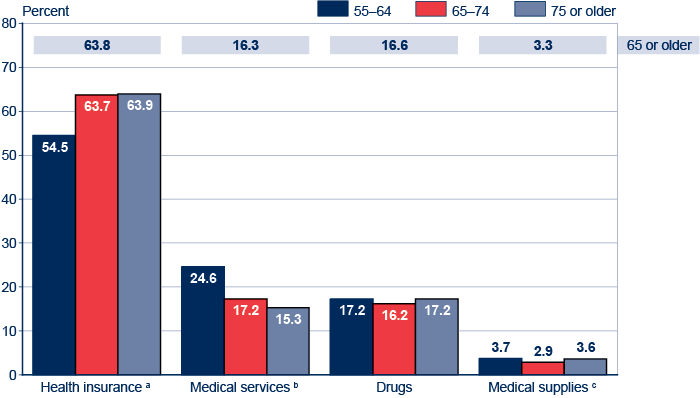
| Component | 55–64 | 65–74 | 75 or older | 65 or older |
|---|---|---|---|---|
| Health insurance a | 54.5 | 63.7 | 63.9 | 63.8 |
| Medical services b | 24.6 | 17.2 | 15.3 | 16.3 |
| Drugs | 17.2 | 16.2 | 17.2 | 16.6 |
| Medical supplies c | 3.7 | 2.9 | 3.6 | 3.3 |
Transportation Expenditures
Transportation expenditures were lower for CUs aged 75 or older than for those aged 55–64, whether expressed as the median percentage of total expenditures allocated to transportation (8 percent compared with 12 percent), median total transportation expenditures ($1,708 compared with $4,976), or median per capita transportation expenditures ($1,200 compared with $2,470).
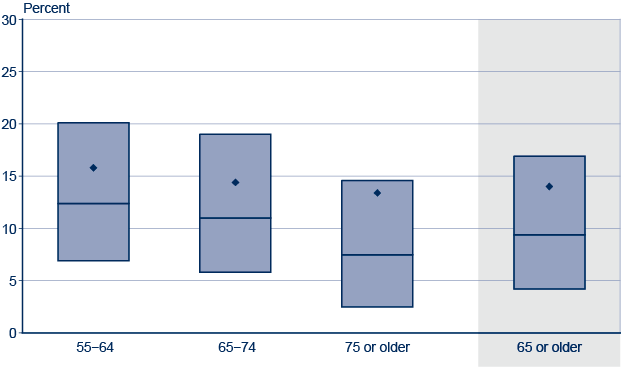
| 55–64 | 65–74 | 75 or older | 65 or older | |
|---|---|---|---|---|
| 75th percentile | 20.1 | 19.0 | 14.6 | 16.9 |
| Median | 12.4 | 11.0 | 7.5 | 9.4 |
| 25th percentile | 6.9 | 5.8 | 2.5 | 4.2 |
| Mean (♦) | 15.8 | 14.4 | 13.4 | 14.0 |
| SOURCE: Interview portion of the 2010 Consumer Expenditure Survey. Means were computed using both the interview and diary portions of the survey. | ||||
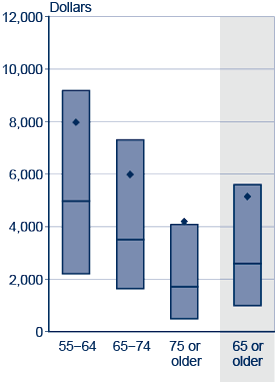
| 55–64 | 65–74 | 75 or older | 65 or older | |
|---|---|---|---|---|
| 75th percentile | 9,192 | 7,308 | 4,084 | 5,600 |
| Median | 4,976 | 3,508 | 1,708 | 2,592 |
| 25th percentile | 2,200 | 1,632 | 480 | 996 |
| Mean (♦) | 7,981 | 5,988 | 4,200 | 5,148 |
| SOURCE: Interview portion of the 2010 Consumer Expenditure Survey. Means were computed using both the interview and diary portions of the survey. | ||||
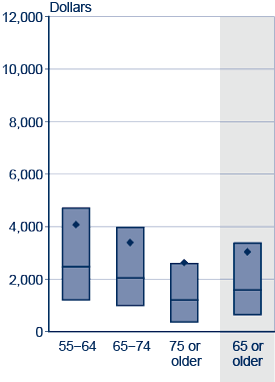
| 55–64 | 65–74 | 75 or older | 65 or older | |
|---|---|---|---|---|
| 75th percentile | 4,712 | 3,972 | 2,592 | 3,366 |
| Median | 2,470 | 2,048 | 1,200 | 1,594 |
| 25th percentile | 1,200 | 990 | 360 | 648 |
| Mean (♦) | 4,078 | 3,397 | 2,631 | 3,037 |
| SOURCE: Interview portion of the 2010 Consumer Expenditure Survey. Means were computed using both the interview and diary portions of the survey. | ||||
Components of Transportation Expenditures
Almost all transportation expenditures were for the purchase and maintenance of vehicles. The purchase of new and used cars and trucks accounted for 32 percent of transportation expenditures for CUs aged 55–64 and 75 or older, and for 27 percent of transportation costs for those aged 65–74. Other vehicle expenditures made up 61 percent of transportation spending for CUs aged 55–64 and 75 or older, and 65 percent of transportation costs for those aged 65–74. Across all age groups, only 7 percent to 8 percent of transportation expenditures went to public transportation.
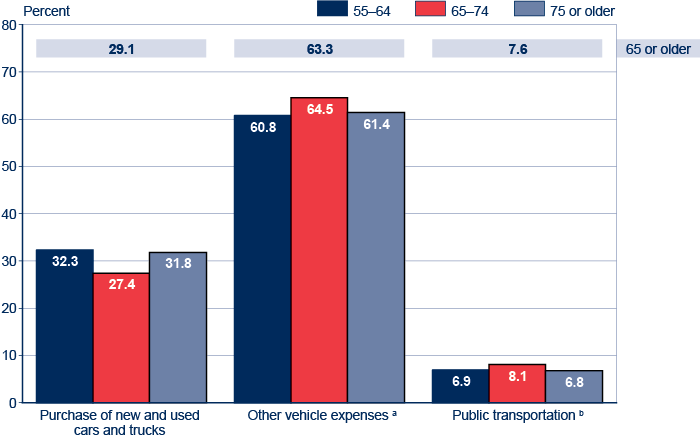
| Component | 55–64 | 65–74 | 75 or older | 65 or older |
|---|---|---|---|---|
| Purchase of new and used cars and trucks | 32.3 | 27.4 | 31.8 | 29.1 |
| Other vehicle expenses a | 60.8 | 64.5 | 61.4 | 63.3 |
| Public transportation b | 6.9 | 8.1 | 6.8 | 7.6 |
Other Expenditures
Other expenditures include such items as alcohol, personal care, reading, education, tobacco, miscellaneous items, cash contributions to persons or organizations outside the CU, personal insurance, pension contributions, and Social Security payroll taxes. As a percentage of total expenditures, median expenditures in the "other" category were 12 percent among CUs aged 55–64, 7 percent among CUs aged 65–74, and 6 percent among CUs aged 75 or older. Mean other-category expenditures exceed the medians by substantial margins mainly because of very high cash contributions to individuals and organizations made by a relatively small percentage of the aged population.
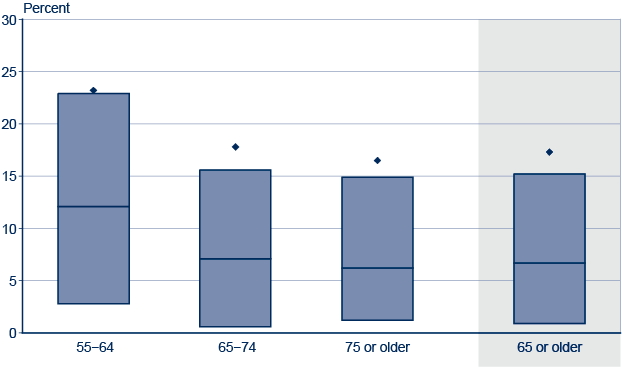
| 55–64 | 65–74 | 75 or older | 65 or older | |
|---|---|---|---|---|
| 75th percentile | 22.9 | 15.6 | 14.9 | 15.2 |
| Median | 12.1 | 7.1 | 6.2 | 6.7 |
| 25th percentile | 2.8 | 0.6 | 1.2 | 0.9 |
| Mean (♦) | 23.2 | 17.8 | 16.5 | 17.3 |
| SOURCE: Interview portion of the 2010 Consumer Expenditure Survey. Means were computed using both the interview and diary portions of the survey. | ||||
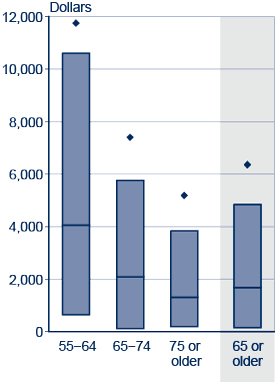
| 55–64 | 65–74 | 75 or older | 65 or older | |
|---|---|---|---|---|
| 75th percentile | 10,615 | 5,770 | 3,840 | 4,843 |
| Median | 4,060 | 2,088 | 1,312 | 1,688 |
| 25th percentile | 632 | 112 | 192 | 160 |
| Mean (♦) | 11,759 | 7,403 | 5,188 | 6,362 |
| SOURCE: Interview portion of the 2010 Consumer Expenditure Survey. Means were computed using both the interview and diary portions of the survey. | ||||
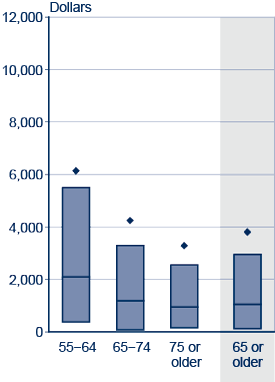
| 55–64 | 65–74 | 75 or older | 65 or older | |
|---|---|---|---|---|
| 75th percentile | 5,511 | 3,300 | 2,560 | 2,960 |
| Median | 2,092 | 1,184 | 952 | 1,050 |
| 25th percentile | 374 | 84 | 152 | 120 |
| Mean (♦) | 6,142 | 4,246 | 3,292 | 3,808 |
| SOURCE: Interview portion of the 2010 Consumer Expenditure Survey. Means were computed using both the interview and diary portions of the survey. | ||||
Components of Other Expenditures
The allocation of other expenditures differs among age groups. Cash contributions were the largest component of other expenditures for CUs aged 65–74 and 75 or older (31 percent and 44 percent, respectively). Social Security payroll taxes were the largest component of other expenditures for CUs aged 55–64 (36 percent).
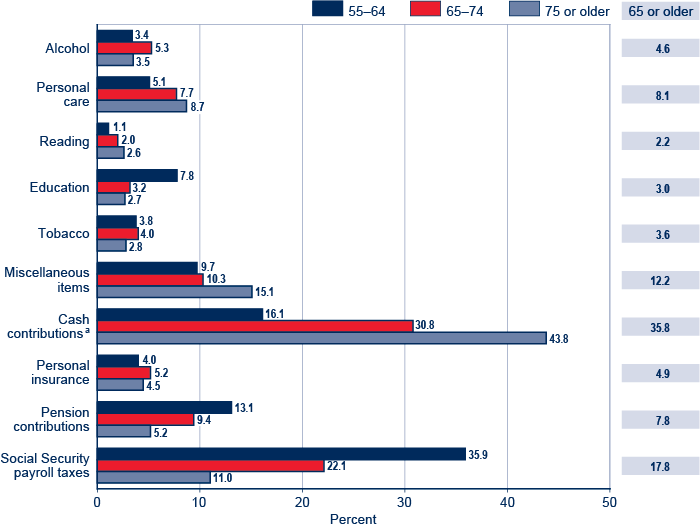
| Component | 55–64 | 65–74 | 75 or older | 65 or older |
|---|---|---|---|---|
| Alcohol | 3.4 | 5.3 | 3.5 | 4.6 |
| Personal care | 5.1 | 7.7 | 8.7 | 8.1 |
| Reading | 1.1 | 2.0 | 2.6 | 2.2 |
| Education | 7.8 | 3.2 | 2.7 | 3.0 |
| Tobacco | 3.8 | 4.0 | 2.8 | 3.6 |
| Miscellaneous items | 9.7 | 10.3 | 15.1 | 12.2 |
| Cash contributions a | 16.1 | 30.8 | 43.8 | 35.8 |
| Personal insurance | 4.0 | 5.2 | 4.5 | 4.9 |
| Pension contributions | 13.1 | 9.4 | 5.2 | 7.8 |
| Social Security payroll taxes | 35.9 | 22.1 | 11.0 | 17.8 |
Travel Expenditures
No more than 31 percent of CUs in the three age groups shown had travel-related expenditures, and the percentage that had such expenditures decreased with age. Travel comprises elements from the housing, food, transportation, and entertainment expenditure categories that are spent on out-of-town trips. This category includes food; alcohol; lodging; gas; rental of autos, trucks, motorcycles, boats, campers, and other vehicles; parking; tolls; fares for travel by airplane, bus, train, and taxi; and recreation and entertainment expenses on out-of-town trips. About 31 percent of CUs aged 55–64, 30 percent of CUs aged 65–74, and 17 percent of CUs aged 75 or older had some expenditures for travel. Among CUs with travel expenditures, the median share of total expenditures allocated to travel was about 4 percent to 5 percent across all age groups.
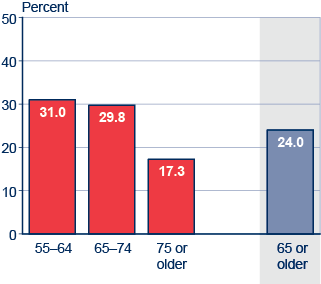
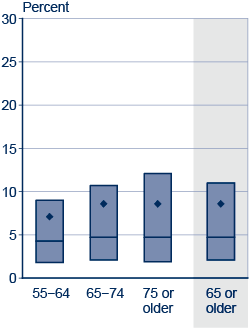
| 55–64 | 65–74 | 75 or older | 65 or older | |
|---|---|---|---|---|
| 75th percentile | 9.0 | 10.7 | 12.1 | 11.0 |
| Median | 4.3 | 4.7 | 4.7 | 4.7 |
| 25th percentile | 1.8 | 2.1 | 1.9 | 2.1 |
| Mean (♦) | 7.1 | 8.6 | 8.6 | 8.6 |
| SOURCE: Interview portion of the 2010 Consumer Expenditure Survey. Means were computed using both the interview and diary portions of the survey. | ||||
CUs Aged 65 or Older: 2002, 2005, & 2010
NOTE: The previous edition of the Expenditures of the Aged Chartbook showed expenditures for 2002. The remainder of this edition shows expenditures in 2002, 2005, and 2010 for CUs aged 65 or older. The Consumer Expenditure Survey is a cross-sectional survey in which the sampled households change from year to year. Therefore, the data presented in these charts are snapshots of all CUs aged 65 or older in those three years; that is, they do not represent the experience of the same group of households from year to year. Expenditures have been indexed to 2010 dollars using the Consumer Price Index for Urban Wage Earners and Clerical Workers (CPI-W).
Trends in CU Size
In general, the size of CUs aged 65 or older grew slightly between 2002 and 2010. The proportion of CUs with just one person fell from 47 percent to 44 percent, while the proportion with two persons rose from 42 percent to 45 percent. The proportion of CUs with three or more persons was about 11 percent in both 2002 and 2010.
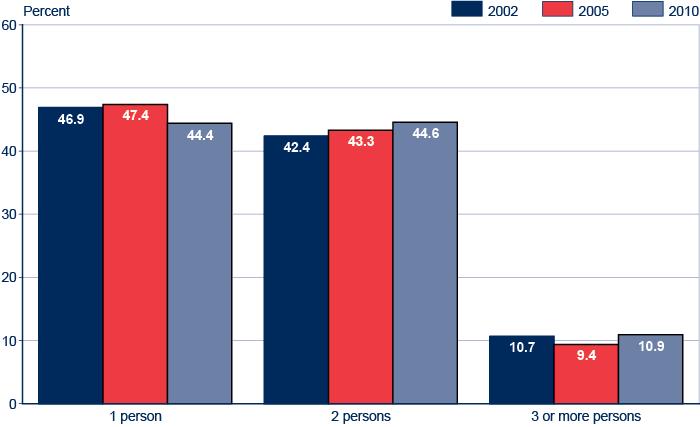
| Size of consumer unit | 2002 | 2005 | 2010 |
|---|---|---|---|
| 1 person | 46.9 | 47.4 | 44.4 |
| 2 persons | 42.4 | 43.3 | 44.6 |
| 3 or more persons | 10.7 | 9.4 | 10.9 |
Trends in Expenditures
Measured in 2010 dollars, median expenditures among CUs aged 65 or older increased from $23,743 in 2002 to $24,935 in 2005 and to $26,485 in 2010 (not shown). The proportion of CUs with total expenditures under $20,000 fell from 40 percent in 2002 to 38 percent in 2005 and to 35 percent in 2010, and the proportion with expenditures over $50,000 increased from 14 percent to 17 percent and to 19 percent.
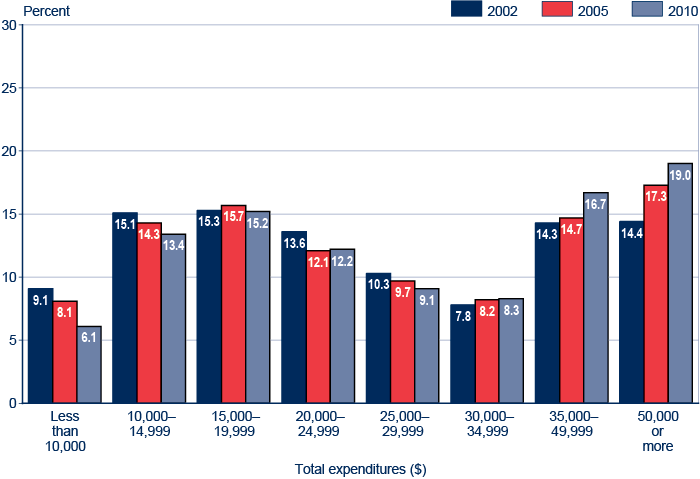
| Total expenditures ($) | 2002 | 2005 | 2010 |
|---|---|---|---|
| Less than 10,000 | 9.1 | 8.1 | 6.1 |
| 10,000–14,999 | 15.1 | 14.3 | 13.4 |
| 15,000–19,999 | 15.3 | 15.7 | 15.2 |
| 20,000–24,999 | 13.6 | 12.1 | 12.2 |
| 25,000–29,999 | 10.3 | 9.7 | 9.1 |
| 30,000–34,999 | 7.8 | 8.2 | 8.3 |
| 35,000–49,999 | 14.3 | 14.7 | 16.7 |
| 50,000 or more | 14.4 | 17.3 | 19.0 |
Trends in the Components of Expenditures
The most notable changes in the distribution of expenditures among CUs aged 65 or older between 2002 and 2010 were the increase in the share of expenditures devoted to housing and the decrease in the proportions allocated to food and transportation. Housing expenditures accounted for 33 percent total aged CU expenditures in 2002, and in 2010 that figure was 35 percent. Food expenditures fell from 14 percent to 12 percent of total expenditures over that period, and the proportion of expenditures allocated to transportation fell from 16 percent to 14 percent.
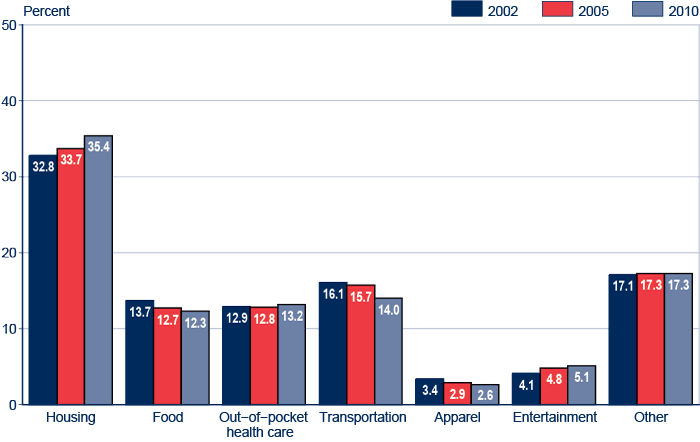
| Component | 2002 | 2005 | 2010 |
|---|---|---|---|
| Housing | 32.8 | 33.7 | 35.4 |
| Food | 13.7 | 12.7 | 12.3 |
| Out-of-pocket health care | 12.9 | 12.8 | 13.2 |
| Transportation | 16.1 | 15.7 | 14.0 |
| Apparel | 3.4 | 2.9 | 2.6 |
| Entertainment | 4.1 | 4.8 | 5.1 |
| Other | 17.1 | 17.3 | 17.3 |
Trends in Housing Tenure
Between 2002 and 2010, the proportions of CUs aged 65 or older that either owned their homes with no mortgage or rented their homes fell slightly, while the share that owned a home with a mortgage increased. The proportion that owned a home without a mortgage fell from 63 percent to 60 percent, while the proportion that rented fell from 20 percent to 18 percent. The share that owned a home with a mortgage rose from 18 percent to 22 percent.
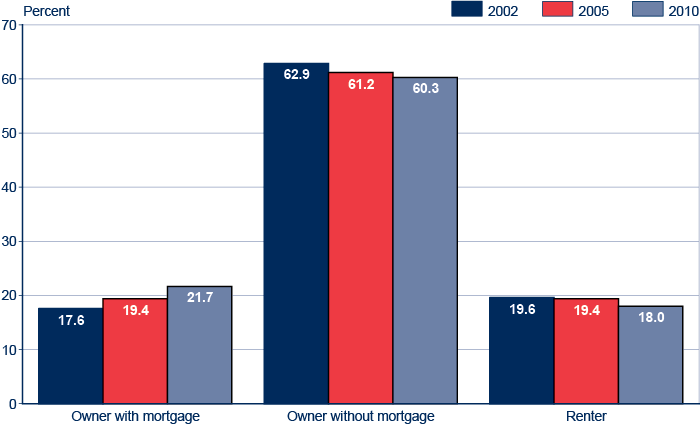
| Housing tenure | 2002 | 2005 | 2010 |
|---|---|---|---|
| Owner with mortgage | 17.6 | 19.4 | 21.7 |
| Owner without mortgage | 62.9 | 61.2 | 60.3 |
| Renter | 19.6 | 19.4 | 18.0 |
Trends in Housing Expenditures by Tenure
As shown earlier, the housing share of total expenditures increased among CUs aged 65 or older between 2002 and 2010. The smallest increase occurred among those who owned a home with no mortgage; for them, housing costs rose from 29 percent to 31 percent of total expenditures. Among those who owned a home with a mortgage, housing rose from 35 percent to 39 percent of total expenditures, while among those who rented their homes, housing rose from 42 percent to 46 percent of total CU expenditures.
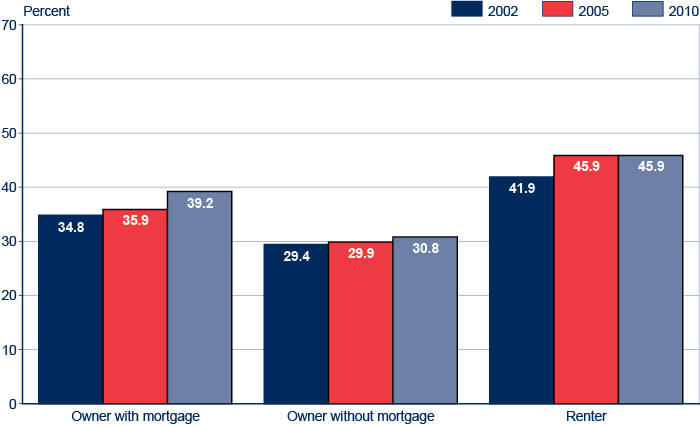
| Housing tenure | 2002 | 2005 | 2010 |
|---|---|---|---|
| Owner with mortgage | 34.8 | 35.9 | 39.2 |
| Owner without mortgage | 29.4 | 29.9 | 30.8 |
| Renter | 41.9 | 45.9 | 45.9 |
Trends in Out-of-Pocket Health Care Expenditures
Between 2002 and 2010, expenditures for health insurance rose sharply while expenditures for prescription and over-the-counter drugs fell among CUs aged 65 or older. Measured in 2010 dollars, mean CU expenditures for health insurance premiums rose from $2,293 in 2002 to $3,091 in 2010. Mean CU expenditures for drugs fell from $1,162 in 2002 to $805 in 2010. Expenditures for medical services rose overall, while expenditures for medical supplies fell, but those two categories together accounted for only about one-fifth of out-of-pocket health care expenditures among elderly CUs in both 2002 and 2010.
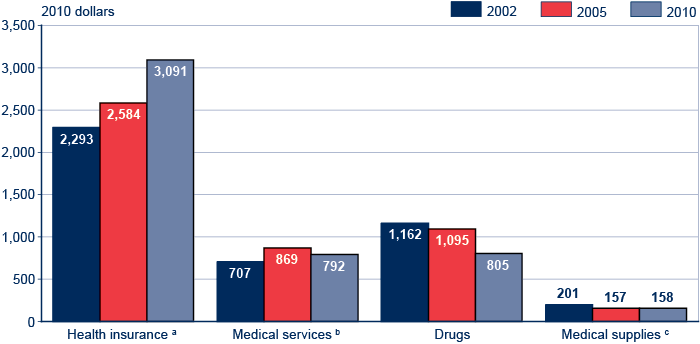
| Component | 2002 | 2005 | 2010 |
|---|---|---|---|
| Health insurance a | 2,293 | 2,584 | 3,091 |
| Medical services b | 707 | 869 | 792 |
| Drugs | 1,162 | 1,095 | 805 |
| Medical supplies c | 201 | 157 | 158 |
Trends in the Components of Out-of-Pocket Health Care Expenditures
As a proportion of total out-of-pocket expenditures for health care, health insurance premiums increased from 53 percent to 64 percent between 2002 and 2010 among CUs aged 65 or older. Expenditures for drugs fell from 27 percent to 17 percent of health expenditures in that span. Combined expenditures for medical services and medical supplies fell from 21 percent of total out-of-pocket health care expenditures in 2002 to 20 percent in 2010.
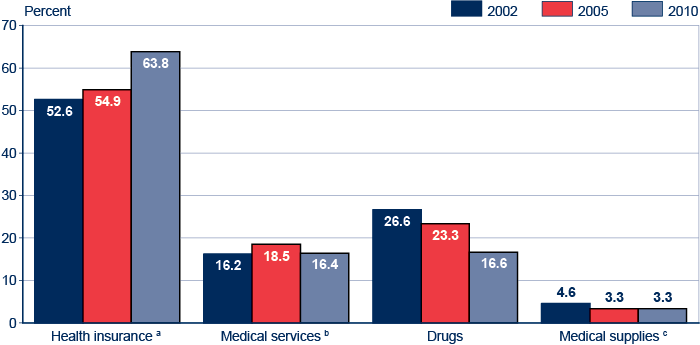
| Component | 2002 | 2005 | 2010 |
|---|---|---|---|
| Health insurance a | 52.6 | 54.9 | 63.8 |
| Medical services b | 16.2 | 18.5 | 16.4 |
| Drugs | 26.6 | 23.3 | 16.6 |
| Medical supplies c | 4.6 | 3.3 | 3.3 |